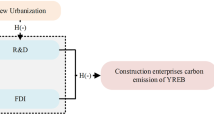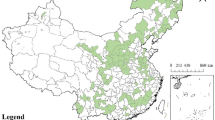Abstract
City-related mitigation measures are crucial for reducing carbon emissions, but most studies on this issue treat cities as independent entities and neglect their interactions. This is especially relevant in the Chinese context, where peers influence policy decisions. Here we offer a novel perspective about mayors’ strategic interactions to explain cities’ carbon intensity reduction. We use a spatial Durbin model to investigate the effects and patterns of interaction on carbon intensity among Chinese cities from 2000 to 2019. We found that mayors’ interaction impacted cities’ carbon intensity, resulting in a 0.792% reduction in reference cities for every 1% decrease in neighboring cities. Mayors with higher education, younger ages, science-related majors and working in their hometowns had better performance. Additionally, we revealed an ‘imitation competition’ pattern (emulating the practices of the neighboring cities). This study offers new insights into city emissions policies and introduces new recommendations.
This is a preview of subscription content, access via your institution
Access options
Subscribe to this journal
Receive 12 digital issues and online access to articles
$119.00 per year
only $9.92 per issue
Buy this article
- Purchase on Springer Link
- Instant access to full article PDF
Prices may be subject to local taxes which are calculated during checkout



Similar content being viewed by others
Data availability
Most of the data in this study are sourced from publicly available data sources. Datasets that are allowed to be shared are available through GitHub at https://github.com/2020000927/-Dynamical-Systems-Laboratory-Strategic-interaction-.git (ref. 48).
Code availability
Analysis was performed using custom-made scripts coded in Stata (Version 16) and MATLAB (Version R2023a). The do file includes the code of baseline model, robust test and temporal and spatial heterogeneity analysis. The m file includes the code of strategic interaction pattern, heterogeneity analysis pilot, rank and turnover). Scripts used for this study are available through GitHub at https://github.com/2020000927/-Dynamical-Systems-Laboratory-Strategic-interaction-.git (ref. 48).
References
Luqman, M., Rayner, P. J. & Gurney, K. R. On the impact of urbanisation on CO2 emissions. npj Urban Sustain. 3, 6 (2023).
Mi, Z. et al. Consumption-based emission accounting for Chinese cities. Appl. Energy 184, 1073–1081 (2016).
Dhakal, S. Urban energy use and carbon emissions from cities in China and policy implications. Energy Policy 37, 4208–4219 (2009).
Liu, Z. et al. Challenges and opportunities for carbon neutrality in China. Nat. Rev. Earth Environ. 3, 141–155 (2022).
CO2 Emissions in 2022 (International Energy Agency, 2023).
Xu, J., Wang, J., Yang, X. & Xiong, C. Peer effects in local government decision-making: evidence from urban environmental regulation. Sustain. Cities Soc. 85, 104066 (2022).
Cheng, Z., Li, L. & Liu, J. The spatial correlation and interaction between environmental regulation and foreign direct investment. J. Regul. Econ. 54, 124–146 (2018).
Xie, X., Ren, S. & Wang, X. “Scrambling”: logic of horizontal competition between local governments based on three cases of interprovincial disaster counterpart support. Chin. J. Pop. Resour. Environ. 20, 251–260 (2022).
Sinn, H.-W. Public policies against global warming: a supply side approach. Int. Tax Public Finance 15, 360–394 (2008).
Peng, X. Strategic interaction of environmental regulation and green productivity growth in China: green innovation or pollution refuge? Sci. Total Environ. 732, 139200 (2020).
Porter, M. E. & van der Linde, C. Toward a new conception of the environment–competitiveness relationship. J. Econ. Perspect. 9, 97–118 (1995).
Greenstone, M., He, G., Jia, R. & Liu, T. Can technology solve the principal-agent problem? Evidence from China’s war on air pollution. Am. Econ. Rev. Insights 4, 54–70 (2022).
Wang, X. & Lei, P. Does strict environmental regulation lead to incentive contradiction?—Evidence from China. J. Environ. Manage. 269, 110632 (2020).
Dong, B., Gong, J. & Zhao, X. FDI and environmental regulation: pollution haven or a race to the top? J. Regul. Econ. 41, 216–237 (2012).
Kahn, M. E., Li, P. & Zhao, D. Water pollution progress at borders: the role of changes in China’s political promotion incentives. Am. Econ. J. Econ. Policy 7, 223–242 (2015).
Wang, J. & Lei, P. The tournament of Chinese environmental protection: strong or weak competition? Ecol. Econ. 181, 106888 (2021).
Tan, J., Tan, Z. & Chan, K. C. The impact of a tournament approach on environmental performance: the case of air quality disclosure in China. Appl. Econ.53, 2125–2140 (2021).
Wheeler, D. Racing to the bottom? Foreign investment and air pollution in developing countries. J. Environ. Dev. 10, 225–245 (2001).
Cai, H., Chen, Y. & Gong, Q. Polluting thy neighbor: unintended consequences of China׳ s pollution reduction mandates. J. Environ. Econ. Manage. 76, 86–104 (2016).
He, G., Wang, S. & Zhang, B. Watering down environmental regulation in China. Q. J. Econ. 135, 2135–2185 (2020).
Chen, H. et al. The impact of low-carbon city pilot policy on the total factor productivity of listed enterprises in China. Resour. Conserv. Recycl. 169, 105457 (2021).
Eaton, S. & Kostka, G. Authoritarian environmentalism undermined? Local leaders’ time horizons and environmental policy implementation in China. China Quart. 218, 359–380 (2014).
Zhang, Y. & Zhu, X. Multiple mechanisms of policy diffusion in China. Public Manage. Rev. 21, 495–514 (2019).
Li, Y. & Shapiro, J. China Goes Green: Coercive Environmentalism for a Troubled Planet (John Wiley & Sons, 2020).
Zheng, S., Kahn, M. E., Sun, W. & Luo, D. Incentives for China’s urban mayors to mitigate pollution externalities: the role of the central government and public environmentalism. Reg. Sci. Urban Econ. 47, 61–71 (2014).
Lo, K. China’s low-carbon city initiatives: the implementation gap and the limits of the target responsibility system. Habitat Int. 42, 236–244 (2014).
Zhang, H., Xiong, L., Li, L. & Zhang, S. Political incentives, transformation efficiency and resource-exhausted cities. J. Clean. Prod. 196, 1418–1428 (2018).
Pu, Z. & Fu, J. Economic growth, environmental sustainability and China mayors’ promotion. J. Clean. Prod. 172, 454–465 (2018).
LeSage, J. & Pace, R. K. Introduction to Spatial Econometrics (Chapman and Hall/CRC, 2009).
Elhorst, J. P. Spatial Econometrics: From Cross-sectional Data to Spatial Panels (Springer, 2014).
Fredriksson, P. G. & Millimet, D. L. Strategic interaction and the determination of environmental policy across US states. J. Urban Econ. 51, 101–122 (2002).
Konisky, D. M. Regulatory competition and environmental enforcement: is there a race to the bottom? Am. J. Polit. Sci. 51, 853–872 (2007).
Mi, Z.-F. et al. Regional efforts to mitigate climate change in China: a multi-criteria assessment approach. Mitig. Adapt. Strateg. Glob. Chang. 22, 45–66 (2017).
Shan, Y. et al. City-level emission peak and drivers in China. Sci. Bull. 67, 1910–1920 (2022).
Wang, Z., Yao, Y. & Zhang, J. The competence-loyalty tradeoff in China’s political selection. J. Comp. Econ. 50, 369–393 (2022).
Corrado, L. & Fingleton, B. Where is the economics in spatial econometrics? J. Reg. Sci. 52, 210–239 (2012).
Dreher, A., Lamla, M. J., Lein, S. M. & Somogyi, F. The impact of political leaders’ profession and education on reforms. J. Comp. Econ. 37, 169–193 (2009).
Tian, Z., Hu, A., Chen, Y. & Shao, S. Local officials’ tenure and CO2 emissions in China. Energy Policy 173, 113394 (2023).
Duan, H. & Hu, Q. Local officials’ concerns of climate change issues in China: a case from Jiangsu. J. Clean. Prod. 64, 545–551 (2014).
Grossman, G. M. & Krueger, A. B. Economic growth and the environment. Quart. J. Econ. 110, 353–377 (1995).
Ahmad, M., Jabeen, G. & Wu, Y. Heterogeneity of pollution haven/halo hypothesis and environmental Kuznets curve hypothesis across development levels of Chinese provinces. J. Clean. Prod. 285, 124898 (2021).
Copeland, B. R. & Taylor, M. S. Trade, growth, and the environment. J. Econ. Lit. 42, 7–71 (2004).
Albornoz, F., Cole, M. A., Elliott, R. J. & Ercolani, M. G. In search of environmental spillovers. World Econ. 32, 136–163 (2009).
Du, K., Li, P. & Yan, Z. Do green technology innovations contribute to carbon dioxide emission reduction? Empirical evidence from patent data. Technol. Forecast. Soc. Change 146, 297–303 (2019).
Li, Z. & Wang, J. Spatial spillover effect of carbon emission trading on carbon emission reduction: empirical data from pilot regions in China. Energy 251, 123906 (2022).
Jin, B. & Han, Y. Influencing factors and decoupling analysis of carbon emissions in China’s manufacturing industry. Environ. Sci. Pollut. Res. 28, 64719–64738 (2021).
China Economic Network. Local Party and Government Leaders Personality Database http://district.ce.cn/zt/rwk/index_21094.shtml (2024).
2020000927. -Dynamical-Systems-Laboratory-Strategic-interaction. GitHub https://github.com/2020000927/-Dynamical-Systems-Laboratory-Strategic-interaction-.git (2024).
Acknowledgements
This work is supported by the National Natural Science Foundation of China under grant no. 72261147760 (C.W.) and the Outstanding Innovative Talents Cultivation Funded Programs 2023 of School of Applied Economics, Renmin University of China (B.Z.). We are grateful to T. Nakaishi of the Faculty of Economics, Kyushu University, for providing some writing suggestions.
Author information
Authors and Affiliations
Contributions
B.Z.: formal analysis, methodology, data curation, writing—original draft, and visualization. C.W.: conceptualization, writing—review and editing, and project administration.
Corresponding author
Ethics declarations
Competing interests
The authors declare no competing interests.
Peer review
Peer review information
Nature Cities thanks the anonymous reviewers for their contribution to the peer review of this work.
Additional information
Publisher’s note Springer Nature remains neutral with regard to jurisdictional claims in published maps and institutional affiliations.
Supplementary information
Supplementary Information
It includes seven sections. Stylized fact and research hypotheses, China’s low-carbon city pilot policy and literature review of strategic interaction sections supplement the research background. Additional method, additional results and data description sections detail the calculation process and robustness tests of the study’s baseline results.
Rights and permissions
Springer Nature or its licensor (e.g. a society or other partner) holds exclusive rights to this article under a publishing agreement with the author(s) or other rightsholder(s); author self-archiving of the accepted manuscript version of this article is solely governed by the terms of such publishing agreement and applicable law.
About this article
Cite this article
Zhu, B., Wei, C. Strategic interactions for carbon emissions in Chinese cities are influenced by mayors. Nat Cities 1, 370–377 (2024). https://doi.org/10.1038/s44284-024-00059-z
Received:
Accepted:
Published:
Issue Date:
DOI: https://doi.org/10.1038/s44284-024-00059-z



